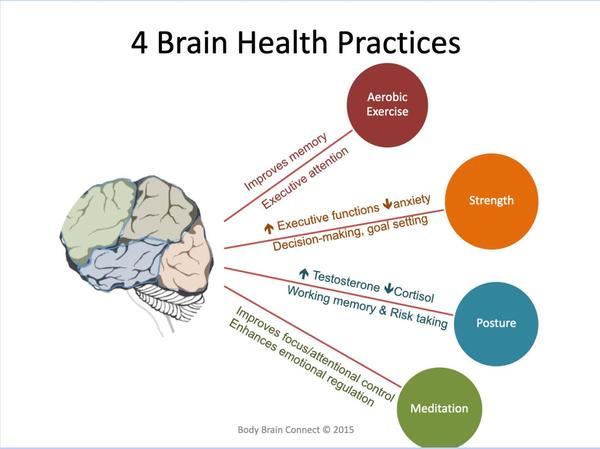Issue #418 – Wednesday, December 06, 2023
How Pilates Extends Your Mind
by Anne Bishop and Chantill Lopez
We know that our individual Pilates practice and teaching experience are both incredibly valuable. Through practice and experience, we also know that Pilates is beneficial for core strength, pelvic floor strength, and flexibility, for improving spinal articulation, and for stabilization of the pelvis and hip joints. And we also know, on some level, that Pilates makes many of our clients feel more confident and uplifts their lives overall.
And, through research, we know that Pilates reduces low back pain, increases self-efficacy, and supports well-being amongst practitioners.
This is all great!
However, what’s largely missing in our industry discussions is how much Pilates can support our minds and brains. This article illustrates how Pilates supports us by staving off cognitive decline AND how the practice of movement improves our brain’s ability to think.
First, we’ll explore how, with the simple (and sometimes not so simple) changes in focus that Pilates requires, we can support brain health both as a practitioner and teacher. Next, we’ll cover how movement can extend our ways of thinking and help us feel more confident in our intelligence AND in our physicality.
A False Dichotomy of Body + Brain
The dichotomy of brain and body is false. In the following paragraphs, we’ll examine just how intertwined our body and brain are as well as exactly how we can choose to lean into either one to support the expansion of our whole selves.
4 Pilates Focuses that Up-level Brain Health
From a physiological perspective, research suggests that cardiovascular exercise protects our brains from cognitive decline. It takes as little as a short walk everyday to reduce natural age-related degradation of the hypothalamus (an important area of the brain for memory recall). Additionally, cardiovascular exercise improves executive attention, which is the ability to plan and set goals at higher levels.
Even though this research just studied walking in older people, we believe there’s also tremendous value in a Pilates session that is not much more challenging than a walk. However, if your goal is to improve memory, we suggest you intentionally increase your students’ heart rates to optimize cardiovascular fitness.
Getting more aerobic fitness into your Pilates programming can include the following:
- Keep the flow going
- Don’t stop and start just because the movements aren’t in perfect form
- More intermediate and advanced level sessions (whether Classical or Contemporary) can easily meet this goal for most people
- Purposefully introduce high-intensity interval training (HIIT) which are bouts of high-intensity workout moments followed by varied recovery time.
- You can weave HIIT moments into your Pilates training by increasing the tempo and/or weight in:
- Footwork on Reformer
- Footwork on Chair
- Footwork on Chair with Arms
- Legs in Straps on Cadillac
*For the deconditioned client, creating shorter and less intense bursts of HIIT work within a Pilates series is more accessible.
Strength training is shown to reduce anxiety if you choose to do it with a 50-60% perceived exertion level. This means the client feels like they are working hard but not you’re not actually maxing out their strength in one or two repetitions.
To improve strength training in the Pilates studio, don’t shy away from heavy springs, especially for clients who struggle with anxiety.
Holding good posture (in neutral spine or extension and taking up space with the limbs) translates to feelings of power within the body, and also shifts the balance of cortisol and testosterone to increase risk-taking, which is good for leaders.
Creating a Pilates session around posture — specifically focused on opening the upper body, shoulder/chest release and expansion, shoulder ROM, head and neck alignment, and a strong center that can ground through the feet — can support clients any time they’re taking a risk like before a job interview, or a big presentation at school.
Finally, meditation (moving or still) 20 minutes at a time, 2 times per day, improves your emotional regulation and can reduce the size of your amygdala (the fear center in your brain) so that your fear response is less destabilizing.
Creating short series like “meditative moments” supports clients to drop into meditation. Beginning with a series like leg circles on the reformer or Cadillac can help clients enter into a moving meditation. Ultimately, the goal is to create 2-5 meditative moments across each Pilates session.
Although it is valuable to look at how different emphases within Pilates can improve brain health, we find that there is a huge piece typically overlooked: how movement improves creativity.
How Moving Extends Our Minds
Seeing HOW practices like Pilates can inform our thinking, innovation, and creativity at a more foundational level is our next step. The material in this section is informed by the work of Annie Murphy Paul.
When we engage in movement with intentionality, we can extend our minds and therefore our ability to problem-solve, innovate, and create.
The latest research has shown that moving our bodies in specific ways can improve our cognition in the short and long term. This means your Pilates sessions can adapt to your clients beyond their physical needs to their cognitive needs later in day and for years down the road.
For example, there is a clear distinction between the cognitive performance of low-intensity workouts compared to that of moderate or high-intensity workouts.
Low-intensity workouts, with a similar exertion level to walking, can increase mental alertness even during the workout. If you’ve ever actively worked on solving a problem while exercising at low intensity it’s because your brain is wired to do so.
Moderate-intensity workouts — where you are pushing yourself but it doesn’t feel like a run — improve your cognitive function during workouts and after you stop.
Finally, intense exercise — likely not practiced in most Pilates sessions — will make it hard to think of new ideas or problem-solve, because your brain can primarily only attend to keeping you moving. At this intensity, you stop thinking, which for some is a state of relief and exactly what they’re aiming for!
Practicing Pilates simply improves brain health. However, by modulating the intensity of the session we can significantly change our cognitive performance.
- What connections are you drawing from this exploration?
- How might your teaching style change now that you know how Pilates and fitness affect brain health, cognition, and creativity?
We’d love to hear your insights and questions.

Chantill and Anne first crossed paths in 2002, each in the midst of building their Pilates businesses in neighboring cities. Nearly ten years later they reconnected and began collaborating on their first continuing education and business development projects. In 2016 they launched the first iteration of their shared business, now known as the Embodied Business Institute. Their mission is to support teachers, business owners, and innovators in the Pilates and movement industries to make money and meaning from expertise.
If you’d like support in your Pilates or embodied business to grow your impact through using brain-based techniques click here to schedule a chat. We’d love to get to know you more and serve our industry.
If you’d like to learn more about neuroscience and curriculum design and what kind of course creator you are take this Embodied Course Creator quiz to find out.

